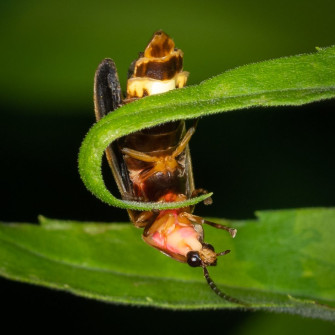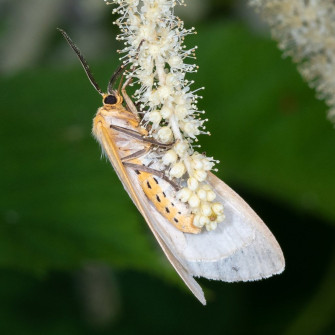
Flies like flowers too
This uncommon thick-headed fly feeds at flowers but is easy to miss because it's only a few millimeters wide. Mountain mint seems to be one of its favorite flowers. This is a she with a long ovipositor, that she typically positions down while feeding. In flight, her legs dangle down. It's believed to parasitizes crickets. With no common name, it's Stylogaster neglecta on Pycnanthemum pilosum.

A bubble blowing fly!
Or maybe it's blowing glass out of its long probiscus. This fly is expelling water. Some flies do this to cool, just like humans perspire. Then they reingest the droplet. But why is this fly doing it - no one seems to know for sure. This is bee fly, not a mosquito. It has a long proboscis, but does not sting. I typically find this tiny fly feeding on sunflowers (aster family flowers). They are parasitoids of larva of some small species of moth. It's Geron calvus on Rudbeckia laciniata.

Pollen balls on bumble bee
This bee looked white - so I was happy to find these balls of pollen on its hairs instead of a disease. Our humidity is so high that everything was wet this morning. Is that why the pollen is in balls? Or is it from a different plant I'm not aware of. One photo and the bee was gone. The bumble bee is on Rudbeckia subtomentosa.

Caterpillar with Fashion Sense
The Wavy-lined Emerald caterpillar bites off pieces of flowers that it attaches to little spines all over its body. Sometimes it's so covered with flower parts that you can't even see the caterpillar. And that's the idea - it's hidden in plain sight! The body of this caterpillar and even some of its spines are visible. You can also see fresh petals from a mountain mint plant, so it has only recently arrived on this rudbeckia flower. As an adult it's a beautiful little lime green moth with wavy lines, of course. It's Synchlora aerate.

Wheeee!
This Halloween Pennant dragonfly was perched on a tall grass whipping around on a breezy day. Pennants are strong fliers and like this one, will lift and move their forewings with the wind. It's Celithemis eponina.

Tiny native Masked Bee
This is a magnified view into a Swamp Milkweed flower cluster. This female looks more like a wasp than other bees because she gathers pollen internally into a "crop" instead of externally on hairs like most other bees. Masked bees are solitary and make their nest in stems and twigs, as well as reusing old tunnels and burrows in the ground. So don't tidy up your garden too much or you won't leave them a nesting locating! It is Hylaeus sp on Asclepias incarnata.

The Moth that's a Hummingbird
One of my favorite regular visitors to our lavender patches of Beebalm is the Hummingbird Clearwing Moth. It hovers around a flower while feeding on wing, in constant motion, and then quickly moving to the next flower. It's Hemaris thysbe, a day flying sphinx moth, feeding on its favorite plant in our meadow - Monarda fistulosa or Wild Bergamot.

Flower with Many Names
This flower has so many common names, I didn't know which to pick! The flower fly only cares about the large pollen source it sees. Here are a few names I found - Gray Headed, Grayhead, Prairie, Yellow, Pinnate Prairie (all ending with coneflower). Many distant plant cousins are also labeled coneflower. To avoid any confusion, this is Eristalis transversa on a Ratibida pinnata flower.

Flashy Beetles
The iridescence of the Dogbane beetle changes appearance to blue-green with metallic copper and gold depending on its position and light. The iridescence along with dimples make it highly reflective (a bugger for photographing). It's a leaf beetle of the plant (can you guess?) ... Dogbane. The Dogbane plant is in the milkweed family, so produces a toxin and excretes a sap that can "glue" the mouth of insects. But the Dogbane Beetle has evolved to overcome these plant defenses and it's believed the beetle uses those toxins against its predators. Dogbane is also known as Indian Hemp because it was historically used to make cord and rope. Scientific names are Dogbane beetle (Chrysochus auratus) on Dogbane (Apocynum cannabinum).

Moth or Butterfly?
This coupled pair are beautifully colored and were flying mid-day. Butterflies have "clubs" or "hooks" on the ends of their antenna, but moths don't. These Orange Mint Moths are day fliers and use mints as larva host plants. We have an abundance of Beebalm (Monarda) and Mountain Mint (Pycnanthemum) for them. The photo looks like night because I shot this with flash and open aperature to get depth of field. This moth also goes by Orange-Spotted Pyrausta and Pyrausta orphisalis.

A Great Golden Digger Wasp on Butterflyweed
This beautiful wasp frequents many different types of flowers, but it color coordinates best with the orange of this milkweed plant. This highly active wasp lets me know it doesn't want me around by buzzing all around me when I get close for photos. Last year one dug its nest between the flagstone edges in our front walk and brought crickets and katydids for its young. Sphex ichneumoneus on Asclepias tuberosa.

Bug Gymnastics
This lightning bug was performing a display an hour before sunset in the sun! At times the abdomen curled up, then the wings and legs lifted, and this crawl around the leaf was the finale. Lightning bugs, or fireflies, are really beetles. This one is a Photinus species.

Day Feeding Moth
When the Goatsbeard is in full flower like this plant, there are tons of pollinators that descend on the plant. This Dogbane Tiger Moth was a surprise. At first I only saw its head from the back side of the flower spike, but it fed around the spike giving me this nice look at its colorful abdomen. Also known as Delicate Cycnia (Cycnia tenera) on Aruncus dioicus.

A Katydid in June?
Yes - to become a singing adult during the heat of the summer, this still small Meadow Katydid nymph has to grow and mature. This one is sunning on a Canada Anemone flower that has an anemone seedpod poking through its pedals. I couldn't have posed this shot much better than nature did on its own.

Caught in the act!
This is a beautiful Anchor Stink Bug. It wasn't until I downloaded the photo that I noticed it was - pooping? Egg laying doesn't seem right. If you know, please comment. It is on Golden Alexanders that has gone to seed. For you techies, that is Stiretrus ancherago on Zizea aurea.